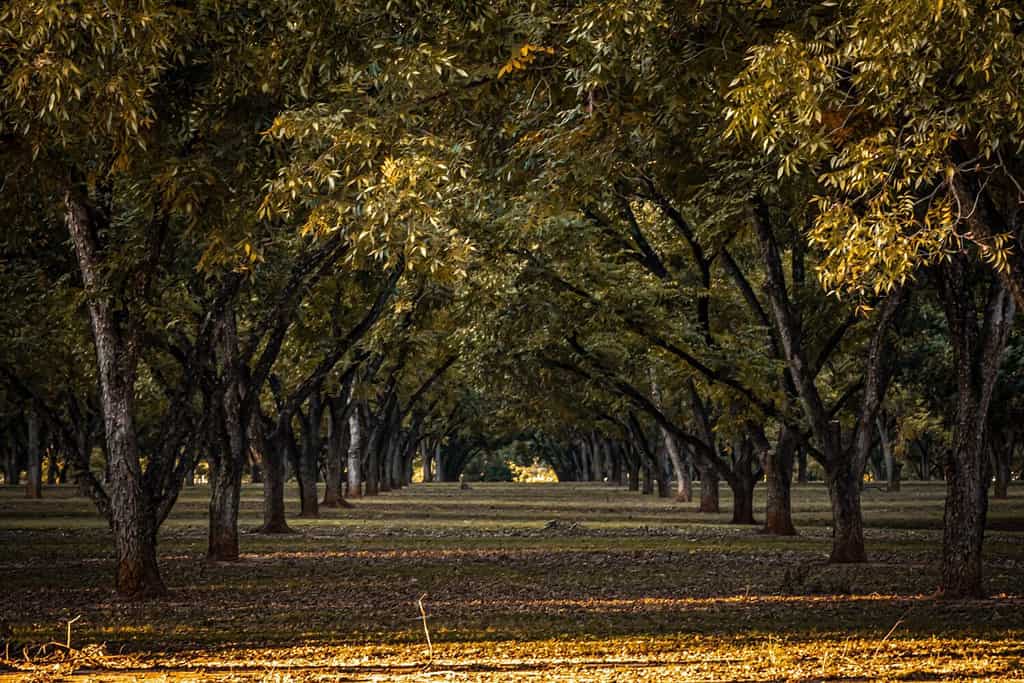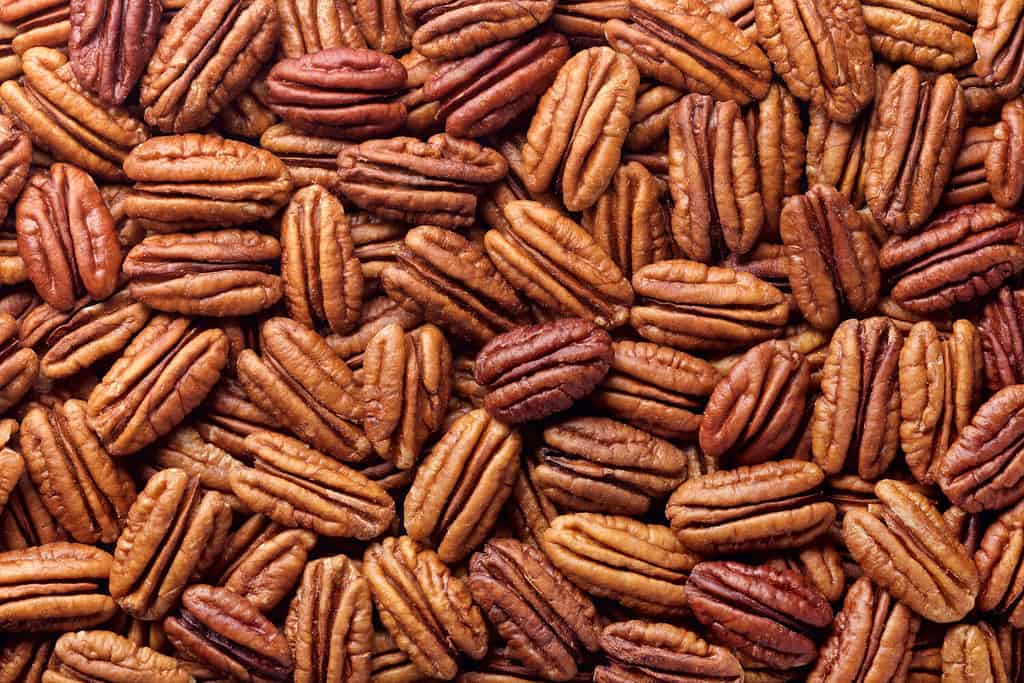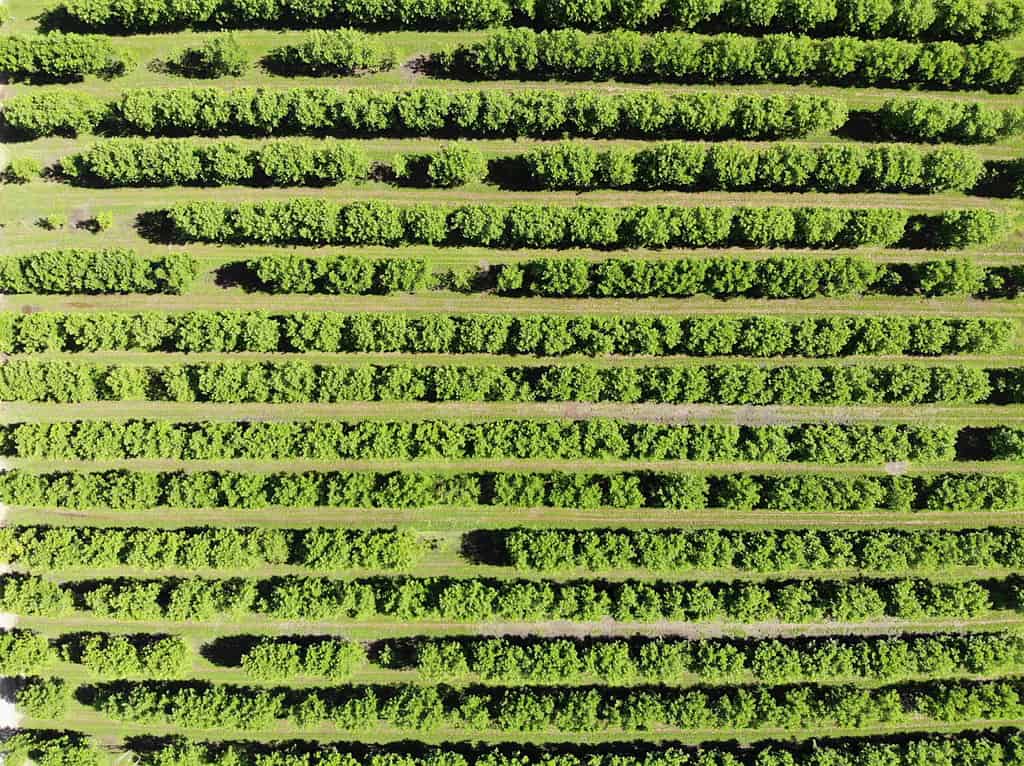Pecans (Carya illinoinensis) are a familiar American staple, and most people living in the United States encounter them at least once per year in holiday pecan pies. What’s it going to be like navigating pecan prices in 2024? What to expect when buying is covered below.
Before we begin, it’s important to note that pecans aren’t truly nuts despite popular nomenclature. Regardless, within this article you’re reading, most sources and almost all marketing outlets will refer to them as nuts. Pecans are seeds from inside a drupe, so they are not a true nut. Drupes are a kind of fruit with a pit that’s sometimes edible, as is the case with pecans.
Where Do Pecans Grow?

Pecans grow best in the southerly states of the USA.
©J. Frederick/Shutterstock.com
Pecans grow best in USDA Plant Hardiness Zones six through nine. This means pecans are generally available directly from the trees in the South and other southerly states.
For a successful crop, pecan trees need over two hundred days without frost conditions. The weather also has to be hot for a time so that the pecans can thrive properly and the trees thrive with lots of sunlight.
Pecans also like soil that drains well, which makes them a popular crop in the arid Southwest. However, they do need proper irrigation, or they won’t yield as large of a product as desired. Individual nuts are often smaller than wanted in drought or desert conditions.
Pecans are in season around the United States near the end of September and into the first part of November. When a pecan tree sheds its mature nuts depends on the weather, including how dry of a summer it had been leading up to harvest. Once nuts have fallen, they still need to cure for a time before they’re ready for processing and sale.
To keep pecan trees as productive as possible, some farmers graft tree seedlings onto existing rootstocks. This usually produces at least twice as much product annually, and nuts from these kinds of trees now dominate the commercial market. However, consumers still seek out naturally grown nuts with enough gusto that an entire market segment exists for native nuts grown from unaltered saplings.
Who Produces the Most Pecans?

The United States produces the most pecans globally, with Georgia usually producing the most by state.
©matin/Shutterstock.com
The United States produces the most pecans in the world, and the State of Georgia consistently grows the largest portion. Georgia alone is responsible for about one-third of the nuts produced in the country. Georgia, New Mexico, Arizona, Texas, and Oklahoma produce most of the pecans grown in the USA.
Despite Georgia’s long-standing reputation for growing the most pecans in the US, in 2023, New Mexico produced the most. New Mexico produced one hundred million pounds as opposed to just under 90 million pounds in Georgia. This happened because the perfect combination of early rains, drought conditions, and prolonged heatwaves damaged the quality of the Georgian crops.
Pecans are the only commercially available tree nut that’s native to the USA. As a result, up to eighty percent of the pecans sold across the globe come from the United States. The last twenty percent are mostly produced in South Africa, Australia, Peru, Mexico, Brazil, and Israel.
More than 500 million dollars worth of pecans are produced annually in the United States. Despite this, pecans are only the fourth most lucrative nut grown within the nation.
Pecan Prices in 2024: Cost Impacts to Expect

Pecan prices fluctuate greatly every year based on weather conditions and exports.
©C Bullock/Shutterstock.com
The bulk pecan prices in 2024 will be about 5 dollars or more per pound still in the shell and over 10 dollars per pound for shelled products. This will translate to approximately 7 dollars for shelled and up to 14 dollars for unshelled pecans per pound at retail prices. Expect these prices to increase a few more dollars per pound if you’re the end consumer using the product at home.
Pecan prices can vary greatly by year due to weather conditions and because of the ebb and flow of pecan crops. Pecan trees produce heavily one year, followed by a light harvest the next year. These cycles are not one hundred percent predictable, which can cause deep fluctuations in the quality of the yearly harvest.
Pecans are in season in the Fall in North America, so their prices are generally the best during this time. If you’re buying a pecan product during the off-season, it’s going to cost more because it’s harder to keep in stock when a nearby harvest isn’t happening.
What to Expect When Buying Pecans

Most consumers seek out plain roasted pecans to use in their home baking.
©MSPhotographic/Shutterstock.com
When buying pecans, there are a few important pricing factors to expect. Where the product is sourced, how processed the pecans are, and how big the export market is for the year are important considerations.
Over forty percent of the United States pecan consumers buy them roasted and sometimes salted. They also buy them for utilitarian purposes like baking. They are much less frequently considered standalone confections such as chocolate-covered for snacking. As a result, simple roasted nuts are going to be much cheaper than snack nuts or other specialty preparations.
Nuts that are raised and processed in the United States are more popular within the country. Also, they fetch a higher price on their home turf. However, quality nuts grown in both the United States and Mexico are often processed in Mexico before being sold to American consumers. Pecans that have taken part in any kind of border crossing are generally lower in price within the United States.
Of all of the pecans grown in the United States, up to forty percent of the yield is sold to other countries, with most of the pecans exported from the United States ending up in China. However, politics are slowly driving the Chinese market to source their nuts from Mexico and Australia. Depending on the state of tumultuous trade negotiations, the amount of pecans going abroad as a Chinese export will greatly affect their market price in the United States.
A Chinese taste for pecans began just a few decades ago. This happened because pecans were widely introduced in the face of a walnut shortage. Before this, pecans were virtually unknown within the country.
What Is a Pecan Tree Exactly?

Pecan trees are a large hickory native to Mexico and the United States.
©iStock.com/Skapie777
Pecan trees are a species of hickory that’s native to parts of the United States and Mexico. These trees are big and often reach over 100 feet tall.
Pecan trees are deciduous, and they start producing a harvest right before their leaves fall in autumn. They don’t produce their first viable crop until they’re 9 years old. They’re also long-lived and can survive up to three hundred years under ideal circumstances.
The nuts from pecan trees are the official state nuts of Louisiana, Texas, Alabama, Arkansas, and California. Pecan trees are also the official state tree of Texas, and pecan pies are the official state pie there as well.
The photo featured at the top of this post is © iStock.com/Say-Cheese
Thank you for reading! Have some feedback for us? Contact the AZ Animals editorial team.







